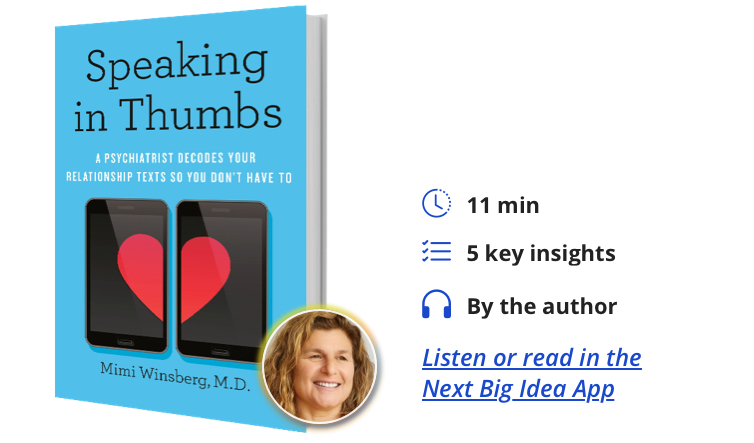Mimi Winsberg is a Stanford-trained psychiatrist, and the co-founder and chief medical officer of Brightside, a national telemental health company. She previously served as the onsite psychiatrist at Facebook. She specializes in the field of digital health, devising algorithms to recognize mental illness though data.
Below, Mimi shares 5 key insights from her new book, Speaking in Thumbs: A Psychiatrist Decodes Your Relationship Texts So You Don’t Have To. Listen to the audio version—read by Mimi herself—in the Next Big Idea App.

1. Texting is a relatively new language, but one we all need to be fluent in.
Texting really took off in 2007 with the proliferation of smartphones, but it has quickly become the main way we communicate with one another. Nowhere is this truer than in romantic relationships. When it comes to modern love, our thumbs do the talking. We swipe right into a stranger’s life, flirt inside text bubbles, connect intimately over text, and use emojis to convey desire, frustration, and ambivalence. We search for clues as to how a relationship is progressing in our partner’s texts, obsess over response times, and wonder why the three-dot ellipsis came…and went.
Texting is more than a shorthand. It exists in the space between spoken language and formal writing, and it’s a language that we are all inventing together as we go along. It lacks many of the nonverbal cues that help people understand one another: eye contact, inflection, facial expression, tone of voice. So, semantics and style have to compensate.
The quality of our relationships is wrapped up in this new language of thumbs, and we are still trying to answer many questions: How quickly should one reply? When is it OK to leave someone on “read”? How much room is there for sarcasm or irony? Should you end sentences with a period, an exclamation mark, or an emoji? Our brains are struggling to catch up to this evolving language.
2. A person’s texts messages are peepholes into their psyche.
Using the principles of “thin slicing”—that is to say, recognizing patterns from a small but representative subset of data—we can use text messages to quickly learn about new people entering our lives. We glean information about their personalities, attachment styles, and more. Research at the intersection of language and psychology, paired with the computational power of data science, has demonstrated that even small samples of text messages can help you detect where a person stands in terms of the Big Five personality factors—or even to identify when someone is depressed. Word choice, grammar, pronoun usage, punctuation, and emoji selection are secret windows into the mind.
“With every thumb tap, we give away tiny pieces of ourselves, and psychological signatures that can be decoded.”
Even single-word analysis can be telling. Extroverts, for example, use the words “mouth” and “other” more frequently, along with question marks, while neurotics are drawn to words such as “awful,” “though,” and “depressing.” Those high in conscientiousness are more likely to pepper phrases with “completed,” “stupid,” and “boring,” while those open to new experiences favor “folk,” “poetry,” “human,” and “always.”
Conclusions can even be drawn from something as seemingly innocuous as pronoun selection. Depressives, for instance, will favor use of the first-person singular pronoun—“I”—over the use of second and third-person pronouns. People who use second person pronouns such as “you” and “your” tend to be more agreeable and conscientious; these are the masters of long-term relationships.
On the other hand, those who emphasize negations such as “no” and “never,” along with the future tense (like “will” and “gonna”), or who draw on cognitive discrepancies (“shoulda,” “coulda,” “woulda”) tend to be less conscientious, and thus less likely to form relationships high in trust.
Our texts leave behind personality fingerprints. With every thumb tap, we give away tiny pieces of ourselves, and psychological signatures that can be decoded.
3. Your text messages are the Rosetta Stone of your relationship.
Not only do a person’s text messages reveal their psychological traits, but looking at an exchange between two people can also reveal features unique to that pair. They can help us decode the kind of relationship we are in, or create the one we want to have. How closely people mirror each other’s style can tell us about chemistry and compatibility. These are the kinds of skills that many of us employ intuitively in person, but we have not yet learned how to do the same over text.
“Looking at an exchange between two people can also reveal features unique to that pair.”
By looking at linguistic elements in text—such as language-style matching and patterns of communication—and decoding the language of power, we can see whether a couple is attuned, what their power dynamics are like, and how they manage conflict. All of these elements can be predictive of the relationship’s long-term sustainability.
People vary in how they prefer to express and receive love over text—their “text love language.” People also deal with stress differently via text message. There are patterned ways in which we express intimacy, autonomy, trust, and anxiety—and text exchanges can telescope all of that.
4. Text threads are like the electronic medical record of our relationships.
Text threads leave a real-time digital exhaust of our romantic communications, and as such, they can help retrospectively diagnose the onset of a relationship’s illness—or, when it’s too far gone, allow us to perform the autopsy.
As a relationship evolves, so do its text messages. Our brains might unconsciously register that an attachment is deepening, or that someone is pulling away, but if pressed, we would have a hard time pinning down precisely how we know it. Sometimes we sense these crossroads at a gut level, through vague sensations of excitement or trepidation. But especially in text, it’s easy to get it wrong—sometimes to the detriment of our relationships.
My work as a psychiatrist is often to help people retrace the fading memory of key conversations—memories often clouded with joy, guilt, or shame. That discussion can be the basis for a cure. With a trail of text messages, we have at our disposal an electronic transcript.
“Reading past text messages for inflection points or transitions in a relationship offers tools for learning from past mistakes and avoiding future ones.”
It’s an invaluable resource in understanding how we relate to the people most important to us. The growing warmth. The lack of empathy. The self-absorption. These things are often only evident from the vantage point of months later. Reading past text messages for inflection points or transitions in a relationship offers tools for learning from past mistakes and avoiding future ones. It allows us to retell the story of our relationship honestly, without illusion, using the raw data at our disposal. Whether it’s done in a moment of uncertainty about the path forward, or as a forensic account after our relationship’s demise, there is much to learn from scrolling back on our text exchanges with a critical eye for pattern recognition.
5. Fluency in the language of thumbs can make you the master of your own destiny.
How many of us have regretted sending a quick message that had consequences that were hard to predict? Who has not been confused or upset from a text message? These short messages, tapped by our thumbs, can be the source of much confusion. Was that sarcasm? Humor? An insult? Our minds have not caught up with the use of this old digit. Thankfully, we have the other four fingers with which to scratch our heads.
By combining behavioral research with examples of real text messages, I provide tools to analyze a person, a pair bond, and the arc of a relationship using text messages alone. I want to arm readers with a knowledge base for looking clearly at the data that lives in the palm of their hand. To be able see that, for example:
- The guy with the attention span of a puppy cursed too much from the start.
- The delightful connection who disappeared like a ghost was too intimate, too quickly.
- The guy who siphoned off all your energy made himself known in his use of possessive pronouns.
- The fight and flight patterns of what would become a tumultuous relationship were all there in our earliest conversation threads.
Once aware of the science and psychology behind texts, you won’t ever see texts the same way again. You’ll learn to identify red flags. You’ll be able to take a more curious, intelligent, and informed approach to all your relationships—romantic, professional, or otherwise.
To listen to the audio version read by author Mimi Winsberg, download the Next Big Idea App today:





























